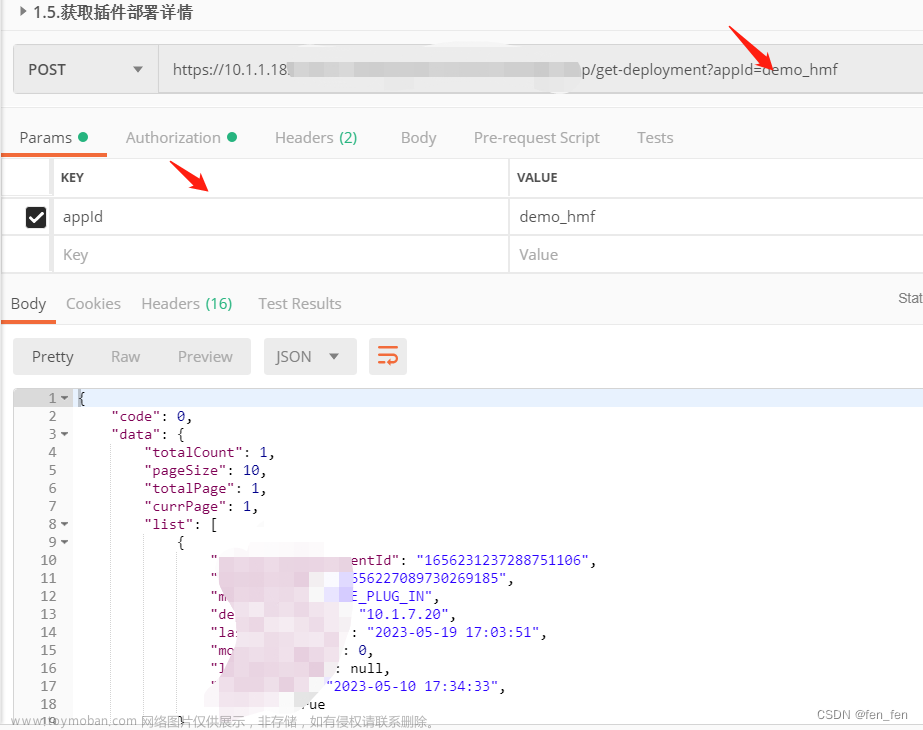Get请求简介
- 1). 创建HttpClient对象,可以使用
HttpClients.createDefault(); - 2). 如果是无参数的GET请求,则直接使用构造方法
HttpGet(String url)创建HttpGet对象即可; - 3)如果是带参数GET请求,则可以先使用
URIBuilder(String url)创建对象,再调用addParameter(Stringparam, String value)`, 或setParameter(String param, String)
value)来设置请求参数,并调用build()方法构建一个URI对象。 - 4). 创建HttpResponse,调用HttpClient对象的
execute(HttpUriRequest
request)发送请求,该方法返回一个HttpResponse。调用HttpResponse的getAllHeaders()、getHeaders(String
name)等方法可获取服务器的响应头; - 5)调用
HttpResponse的getEntity()方法可获取HttpEntity对象,该对象包装了服务器的响应内容。程序可通过该对象获取服务器的响应内容。通过调用getStatusLine().getStatusCode()可以获取响应状态码。 - 6). 释放连接。
构建一个Maven项目,引入如下依赖
<!-- https://mvnrepository.com/artifact/org.apache.httpcomponents/httpclient -->
<dependency>
<groupId>org.apache.httpcomponents</groupId>
<artifactId>httpclient</artifactId>
<version>4.5.8</version>
</dependency>
get无参数
如果是无参数的GET请求,则直接使用构造方法HttpGet(String url)创建HttpGet对象即可
/**
*普通的GET请求
*/
public class DoGET {
public static void main(String[] args) throws Exception {
// 创建Httpclient对象
CloseableHttpClient httpclient = HttpClients.createDefault();
// 创建http GET请求
HttpGet httpGet = new HttpGet("http://www.baidu.com");
CloseableHttpResponse response = null;
try {
// 执行请求
response = httpclient.execute(httpGet);
// 判断返回状态是否为200
if (response.getStatusLine().getStatusCode() == 200) {
//请求体内容
String content = EntityUtils.toString(response.getEntity(), "UTF-8");
//内容写入文件
FileUtils.writeStringToFile(new File("E:\\devtest\\baidu.html"), content, "UTF-8");
System.out.println("内容长度:"+content.length());
}
} finally {
if (response != null) {
response.close();
}
//相当于关闭浏览器
httpclient.close();
}
}
}
get有参数
如果是带参数GET请求,则可以先使用URIBuilder(String url)创建对象,再调用addParameter(Stringparam, String value)
public class HttpclientTest {
@Test
public void httpGet() throws IOException {
// 1.创建httpclient
CloseableHttpClient httpClient = HttpClients.createDefault();
//2. 创建HttpGet,设置URL访问地址
String urlTest = "https://XXXX/XXX/shopping/platformInfo?platformid=7";
HttpGet httpGet = new HttpGet(urlTest);
// 3. 请求执行,获取响应
CloseableHttpResponse response = httpClient.execute(httpGet);
//解析响应
if (response.getStatusLine().getStatusCode() == 2000) {
String content = EntityUtils.toString(response.getEntity(), "UTF-8");
System.out.println(content.length());
}
// 4.获取响应实体
HttpEntity entity = response.getEntity();
System.out.println(EntityUtils.toString(entity, "utf-8"));
response.close();
httpClient.close();
}
代码中使用的是公司接口,请求URL前缀就XXX表示了,get请求如图所示
运行结果:我们已经看到get接口成功返回一条数据
Post请求简介
- 1). 创建HttpClient对象,可以使用
HttpClients.createDefault(); - 2). 如果是无参数的POST请求,则直接使用构造方法HttpPost(String url)创建HttpPost对象即可;
- 3)如果是带参数POST请求,先构建HttpEntity对象并设置请求参数,然后调用setEntity(HttpEntityentity)创建HttpPost对象。
- 4). 创建HttpResponse,调用HttpClient对象的
execute(HttpUriRequest
request)发送请求,该方法返回一个HttpResponse。调用HttpResponse的getAllHeaders()、getHeaders(String
name)等方法可获取服务器的响应头; - 5)调用
HttpResponse的getEntity()方法可获取HttpEntity对象,该对象包装了服务器的响应内容。程序可通过该对象获取服务器的响应内容。通过调用getStatusLine().getStatusCode()可以获取响应状态码。 - 6). 释放连接。
post携带JSON参数
如果是带JSON参数POST请求,先构建HttpEntity对象并设置请求参数,因为我们的参数是JSON格式的,需要将请求对象转换成string类型的,然后调用setEntity(HttpEntityentity)创建HttpPost对象
首先我们先创建一个请求实体类PostData,代码如图所示
/**
* @param
* @author wcy
* @create 2022/10/15
* @return
* @description
**/
public class PostData {
private String categoryid;
private int currentPage;
private String end_time;
private int pageSize;
private int platformid;
private String start_time;
private int step_id;
public String getCategoryid() {
return categoryid;
}
public void setCategoryid(String categoryid) {
this.categoryid = categoryid;
}
public int getCurrentPage() {
return currentPage;
}
public void setCurrentPage(int currentPage) {
this.currentPage = currentPage;
}
public String getEnd_time() {
return end_time;
}
public void setEnd_time(String end_time) {
this.end_time = end_time;
}
public int getPageSize() {
return pageSize;
}
public void setPageSize(int pageSize) {
this.pageSize = pageSize;
}
public int getPlatformid() {
return platformid;
}
public void setPlatformid(int platformid) {
this.platformid = platformid;
}
public String getStart_time() {
return start_time;
}
public void setStart_time(String start_time) {
this.start_time = start_time;
}
public int getStep_id() {
return step_id;
}
public void setStep_id(int step_id) {
this.step_id = step_id;
}
}
@Test
public void httpPost() throws IOException {
// 1.创建httpclient对象
CloseableHttpClient httpClient = HttpClients.createDefault();
// 2.创建post对象,设置URL访问地址
String url = "https://XxX/XxX/shopping/goodsRank";
HttpPost httpPost = new HttpPost(url);
CloseableHttpResponse response = null;
try {
PostData data = new PostData();
data.setCategoryid("");
data.setCurrentPage(1);
data.setEnd_time("2022-11-02");
data.setPageSize(20);
data.setPlatformid(1);
data.setStart_time("2022-11-02");
data.setStep_id(464);
String bodyEntity = JSON.toJSONString(data);
HttpEntity entity = new StringEntity(bodyEntity, ContentType.APPLICATION_JSON);
httpPost.setEntity(entity);
//发送post请求
response = httpClient.execute(httpPost);
//解析响应
if (response.getStatusLine().getStatusCode() == 200) {
//获取响应数据
entity = response.getEntity();
System.out.println(EntityUtils.toString(entity, "utf-8"));
}
}catch (IOException e){
e.printStackTrace();
}
}
运行结果:
post携带表单参数
post请求传递参数的形式是将参数放入表单请求体中,然后将表单对象放入请求体中传递。
//1.获得一个httpclient对象
CloseableHttpClient httpclient = HttpClients.createDefault();
//2.生成一个post请求
HttpPost httpPost = new HttpPost("http://www.baidu.com/");
//3.请求参数添加到请求体中,表单提交
List<NameValuePair> nvpList = new ArrayList<NameValuePair>();
nvps.add(new BasicNameValuePair(key, val));
UrlEncodedFormEntity formEntity = new UrlEncodedFormEntity(nvps, charset);
httpPost.setEntity(formEntity);
//4.执行get请求并返回结果
CloseableHttpResponse response = httpclient.execute(httpPost);
try {
//5.处理结果响应体
HttpEntity entity = response.getEntity();
} finally {
response.close();
}
postman自动生成OKhttp代码
首先在postman编写好post请求的URL,请求参数,请求方式,请求头
点击sends按钮右侧的code弹窗展示,如图所示
框里面的代码就是自动生成的,我们可以复制代码到idea中,需要在maven`装下OKhhtp的依赖
官网连接:https://mvnrepository.com/文章来源:https://www.toymoban.com/news/detail-742454.html
OkHttpClient client = new OkHttpClient().newBuilder()
.build();
MediaType mediaType = MediaType.parse("text/plain");
RequestBody body = new MultipartBody.Builder().setType(MultipartBody.FORM)
.addFormDataPart("categoryid","")
.addFormDataPart("currentPage","1")
.addFormDataPart("end_time ","2022-11-01")
.addFormDataPart("pageSize","20")
.addFormDataPart("platformid ","1")
.addFormDataPart("start_time ","2022-11-01")
.addFormDataPart("step_id ","464")
.build();
Request request = new Request.Builder()
.url("https://XXX/XXX/shopping/goodsRank")
.method("POST", body)
.addHeader("Cookie", "laravel_session=eyJpdiI6IkRxcWx6M201UHRWMWFWeDY3b0RURmc9PSIsInZhbHVlIjoid0pSM241cmgvRUk5WndHTnc2azlzNFpHVDh6MCt5R1pSV21pQXRPRDB1eEpyMThNZVUrelRKYzJHSVUzNHp3T290RHppOVNvSFZ3Z2VCQ2g4SEFQUjBXSGpRL3VkcUJiRUFzRGc5b21BRnhOUUwzUkNENlhzUEJlVGtWZkhZNGoiLCJtYWMiOiIyYzM1NDhkYzQ0YmZiNjQ5OWIwZjg1NDA3NTYxZTcyM2IyODAxNWI1ZGU4NmEzOTE2YjRmOTBjYzQzMzUyNjY1In0%3D")
.build();
Response response = client.newCall(request).execute();
System.out.println(response);
}
OKhttp的语法跟httpclient差不多,都是http工具类文章来源地址https://www.toymoban.com/news/detail-742454.html
到了这里,关于httpclient发送Get请求和Post请求的文章就介绍完了。如果您还想了解更多内容,请在右上角搜索TOY模板网以前的文章或继续浏览下面的相关文章,希望大家以后多多支持TOY模板网!









